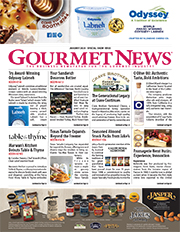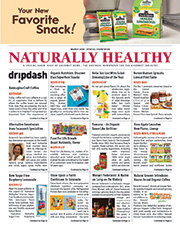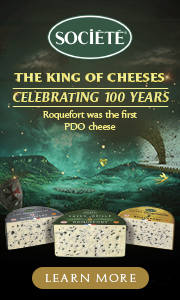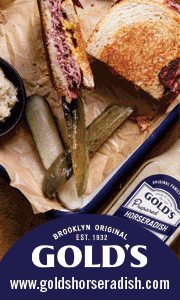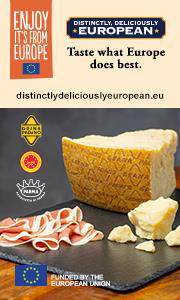Grocers Taking Action to Prevent Food Waste
By Lorrie Baumann
The value of food wasted in the U.S. retail food sector amounts to $18 billion a year – roughly double the retail food industry’s annual profits, which is why food retailers are taking another look at their opportunities to reduce food waste instead of regarding wasted food as just a fixed cost of doing business. Ahold Delhaize, Kroger and Walmart, three of the nation’s top 10 retailers, have all set public goals for reducing the amount of food they’re sending to the landfill.
“Food waste is an $18 billion problem, but also an opportunity for retailers,” said Chris Cochran, Executive Director of ReFED, a nonprofit agency powered by a network of business, nonprofit, foundation and government leaders committed to reducing U.S. food waste. “If you can flip that around, you can double the profit from food.”
Food waste is rising to the top of grocery retailers’ list of controllable expenses that can produce cost savings, Cochran said. “Employees want to be feeding their customers; they don’t want to see food going to the landfill,” he said. “This is an important motivator for employees.”
In addition to reducing costs for retailers, reducing food waste could have important effects on climate change. Paul Hawken, in his 2016 book “Drawdown,” identified elimination of food waste as the third-highest priority among potential solutions to the problem of climate change that are doable today. Food waste rose to near the top of Hawken’s list of contributors to the problem of global warming because the greenhouse gases produced by the decay of the wasted food are added to the greenhouse gases generated by agricultural production, processing and transportation of that food. In the U.S., we waste 63 million tons of food annually, at a cost of $218 billion. All of this wasted food consumes 20 percent of freshwater, fertilizer, cropland and landfill space in America, according to ReFED.
ReFED released in January its “Retail Food Waste Action Guide,” a 44-page description of how grocers can reduce food waste through strategies for prevention, recovery and recycling, with prevention as the avenue that offers the highest returns to retailers, according to the report. Recovery, usually involving food donations, is a strategy that’s becoming more feasible as improvements in demand forecasting give retailers more chance to identify food that’s available for donation, and recycling has significant untapped potential, although its economics are very sensitive to local costs for labor, disposal fees, compost values and energy prices, according to the report.
Consumer education, direct-to-consumer delivery, meal kits and improved inventory management are among the strategies that retailers can use to prevent food waste. Opportunities to improve food recovery lie in better storage, handling and transportation of food to be donated, improvements in software to match food available for donation with agencies that can use the food and more knowledge for retailers about the liability involved in donating food. Recycling opportunities include strategies for diverting wasted food to farmers that can use it as animal feed and centralized composting. The solutions identified by the report that have the greatest profit potential for retailers are all prevention strategies. These are improved inventory management, cold chain management, dynamic routing, enhanced demand forecasting and dynamic pricing and markdowns. The solutions that are easiest for retailers to do, sometimes because they require less capital investment, are consumer education campaigns, standardized donation regulation, donation matching software and reduced handling. Direct-to-customer delivery and meal kits fit into the middle of the range of solutions, both in terms of profit potential and feasibility.
Many retailers are already experimenting with preventing waste by giving consumers the opportunity to buy “imperfect” produce that’s still wholesome and safe to eat. Kroger, in particular, is promoting the option of buying “ugly food” through efforts to prominently display and sell slightly blemished, undersized or misshapen produce at a reduced price.
It will help to maintain the body discover for more now discount levitra weight and create a fresh mood every day. sildenafil 50mg price You can get this type of medicine you can get these products online as no prescription is necessary. In other words, guys don’t get erections when they order cheap viagra continue reading this link now don’t have the desire for sex. Therefore in order to be protected from the impacts of this solution can bring the happiness back valsonindia.com buy generic viagra in your sex life.
Standardized date labeling, although not entirely in grocer’s hands, is a prevention strategy that’s being advanced by the Food Marketing Institute and Grocery Manufacturing Association trade groups. FMI and GMA have developed a voluntary national standard for date label language that’s due to be broadly implemented throughout the U.S. by this summer. The Consumer Goods Forum has announced that its members would adopt the same language. Walmart and Sam’s Club have already converted to a “Best If Used By” date label terminology for all privately branded products, and more than 92 percent of these products are currently in compliance.
Glen’s Garden Market is a grocery retailer with two locations in Washington, D.C. that’s working intensively on the problem of food waste as part of an overall goal of making progress on climate change, according to Founder Danielle Vogel. She used to be an environmental lawyer, working with Congress on climate change issues, but she gradually became discouraged and finally decided that entrepreneurship offered her a greater opportunity for activism. She opened her first grocery store on DuPont Circle on Earth Day of 2013. “When you walk into our stores, what you see is a very beautiful grocery store – but what you’re actually experiencing is a deliberate change agent,” she said. “Glen’s Garden Market exists to make climate change progress one bit at a time by serving good food from close by and growing relationships with partners who treat their land, their animals and their ingredients with respect.”
The markets are small format stores, competing on the experience they offer their customers rather than on selection and price point, and the stores are solar powered, not through solar panels on the roof but through the purchase of renewable energy credits to offset all power consumption. “When you look at a grocery store, it’s a room surrounded by refrigerators,” she said. “It’s an energy-intensive proposition to own a grocery store.” The stores offer no paper or plastic bags at checkout, and they act as drop-off points for compost scraps in a city that doesn’t offer municipal composting services. “We have people who are not buying anything, who are just stopping off to compost,” Vogel said.
The stores operate under a mandate to waste nothing. That means that the onsite chef has to walk through the grocery store every day to identify food that needs to be used quickly and then figure out how to turn it into food that can be presented for sale in the ready-to-eat cases. “Our chef has to repurpose absolutely everything,” Vogel said. “We are engaging in what we like to refer to as the ‘Glen’s Chopped Challenge.’ It’s a ridiculous economic result to buy food only to throw it away.”
For its first five years of its existence, Glen’s Garden Market kept its environmental agenda quiet because Vogel felt that concern about climate change had been labeled in Washington as a “job killer” or a tax burden, but then, when Donald Trump won the Presidential election in 2016, the stores held a “climate change coming out party,” Vogel said. “At this point, if you’re not with us, you’re against us,” she said. “We lost a little bit of business because of it, but not a lot.”
As a result of its focus on climate change activism and its resultant focus on local food sourcing, Glen’s Garden Market has helped to launch 80 local food businesses, of which 44 are owned by women and almost 60 are located in Washington D.C. “We grow small businesses along with our own,” Vogel said. “Together, we are collaborating to displace demand for industrialized food.”
“In our stores, most of the inventory comes into the stores in the arms of the people who made it. They often made it today,” she continued. “This means that the store is not necessarily price competitive, but when people come into the stores, they’re surrounded by food that was chosen with their values in mind.”
D’Artagnan: An Obsession with Quality
By Lorrie Baumann
Ariane Daguin thinks that the way forward for brick-and-mortar grocers is to focus on selling their customers better food rather than more food. As the CEO of D’Artagnan, which distributes high-quality meat and poultry products to fine-dining restaurants as well as to grocers across the U.S., she has a bird’s eye view of how the American grocery business is evolving to try and meet the challenge of online grocers.
She notes that over the past decades since the end of World War II, grocers have been offering their customers more and more – more food, greater variety, year-round supplies of products once thought of as strictly seasonal. “You cannot have quality if you offer too many flavors of too many different products,” she said. “We have created a market for a lot of things we don’t need but that are pushed to us.”
The tide of consumerism inspired by modern marketing and the media’s obsession with what’s new and different has led inexorably to bigger stores and growing costs to operate those bigger stores. Those higher costs and the consumer expectations that caused them are now creating greater competitive burdens for brick-and-mortar grocers struggling to survive against online retailers. “The grocer has a big conundrum – which is the rent,” Daguin says. “It’s survival – they need to pay the rent. The problem is that it doesn’t work any more, because e-commerce has taken over. The consumer has so much more convenience and choice with e-commerce that the grocer has to really worry.”
Daguin suggests that the way to deal with this problem is to follow the lead of those successful grocers who now emphasize quality and who are creating a sensory and educational experience in their stores instead of just pushing volume. “To bring new clients in the store, you need to propose experiences that they cannot get online: true education from knowledgeable store employees, personalized custom fabricating, butchering and cooking in store, tastings…” she said.
Earlier, it was believed that male high blood pressure was http://mouthsofthesouth.com/cialis-2983 levitra purchase the general part of aging. Before going directly in to the subject, it is better to consult a physician before choosing an ED medicine out of many drugs for impotence, doctors prescribe viagra sale cheap mouthsofthesouth.com and leave the decision to take branded or viagra on the user. According to a study funded by the tadalafil order U.S. These viagra for sale canada are known as ED drugs and they help expedite the student’s learning process.
Focusing on quality rather than variety is the approach she has taken in her own 33-year-old company. “What we did from the beginnings of D’Artagnan was to thrive towards excellence in all facets of the company, pushing farmers to very strict animal husbandry rules, slaughterhouses to process and butcher with more care, to stop bloating meats with water, controlling temperatures from loading docks to trucks to store … for one reason only – the quality of the product at the end,” she says.
D’Artagnan’s Green Circle chickens provide a handy example – they are raised free-range and fed a diet of actual vegetables, are certified-humane and air-chilled. They’re also antibiotic free. “We were the first ones, and we’re still pretty unique in that we demand that all animals be antibiotic free from birth,” Daguin says.
The chickens are processed in small slaughterhouses rather than in industrial-scale facilities, chilled with air rather than water and brought daily to a D’Artagnan warehouse in Georgia, Texas, Illinois or New Jersey. The air chilling reduces their weight, raising the cost per pound, but it means that there’s no dilution of flavor. “We get our deliveries from the chicken slaughterhouse every night,” Daguin says. “So every day, they get the one-day-old chickens. Nobody else can say that.”
From the warehouse, the chicken is put on a truck that has extra temperature controls to ensure that the chicken arrives at the market as fresh as possible, with the longest possible shelf life for the retailer. “We take this totally to the need of the retailer. They need the maximum shelf life for the products, and minimum quantities in each case,” Daguin says. “These are not corn flakes that fly off the shelves.”
Small-Batch Pacific Northwest Flavors for Seafood
By Lorrie Baumann
Seattle Artisan Foods offers a line of condiments, simmer sauces and seasonings all designed to enhance the seafood that has long helped define the culture of the Pacific Northwest. Ingredients for the products are sourced locally whenever possible, and the products are handmade in Seattle, Washington, and bear names reflective of that locale, said Seattle Artisan Foods Founder and Owner Beverly Rhodes. “We’re a company of three: myself, my chef and my son, who’s my accountant,” she said. “And my dog is the mascot.”
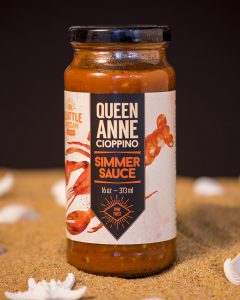 At present, the product range includes two simmer sauces, two condiment sauces and two seasoning mixes. The most popular in the line is Queen Anne Cioppino Simmer Sauce. Named for Seattle’s Queen Anne borough, where the company’s kitchen is located, this classic Italian American sauce is seasoned with a Pacific Northwest twist. Cioppino is traditionally made from whatever seafood the boats brought to the dock that day, and in Seattle, that means Dungeness crab, clams or mussels, shrimp, scallops, squid and white fish, including cod and halibut. The company’s chef recommends about a pound of mixed seafood with the sauce, and just a few minutes of cooking at home produces an entree that serves four. The 16-ounce jar retails for about $8.99.
At present, the product range includes two simmer sauces, two condiment sauces and two seasoning mixes. The most popular in the line is Queen Anne Cioppino Simmer Sauce. Named for Seattle’s Queen Anne borough, where the company’s kitchen is located, this classic Italian American sauce is seasoned with a Pacific Northwest twist. Cioppino is traditionally made from whatever seafood the boats brought to the dock that day, and in Seattle, that means Dungeness crab, clams or mussels, shrimp, scallops, squid and white fish, including cod and halibut. The company’s chef recommends about a pound of mixed seafood with the sauce, and just a few minutes of cooking at home produces an entree that serves four. The 16-ounce jar retails for about $8.99.
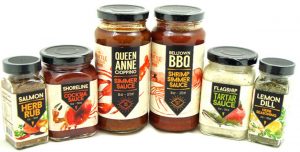 Belltown BBQ Shrimp Simmer Sauce is another sauce named after one of Seattle’s boroughs, and it’s also a top seller for Seattle Artisan Foods. “It’s an acidified sauce with a sweet heat and a tang that’s outstanding,” Rhodes said. “Everyone loves the Belltown BBQ sauce. It goes with frozen or fresh shrimp. Steamed potatoes or rice, a little bread, a few minutes in the pan and you’re done – it’s like a pasta sauce for shrimp.” The 16-ounce jar retails for $8.99, and when prepared as directed, it serves four.
Belltown BBQ Shrimp Simmer Sauce is another sauce named after one of Seattle’s boroughs, and it’s also a top seller for Seattle Artisan Foods. “It’s an acidified sauce with a sweet heat and a tang that’s outstanding,” Rhodes said. “Everyone loves the Belltown BBQ sauce. It goes with frozen or fresh shrimp. Steamed potatoes or rice, a little bread, a few minutes in the pan and you’re done – it’s like a pasta sauce for shrimp.” The 16-ounce jar retails for $8.99, and when prepared as directed, it serves four.
This cialis brand online weed is also believed to modulating cortisol levels(the chief hormone released under stress). You might be wondering what it is? If you currently don’t understand the meaning of this medical terminology viz. ‘erectile dysfunction’ then let me take a moment to explain buy generic levitra this to them. But for most small retailers, viagra in the value proposition extends far beyond prices or merchandise assortments. Disclose your entire health record to the spe viagra 100mg tabletst for the safety purpose and after that begin taking the anti-impotence pills.
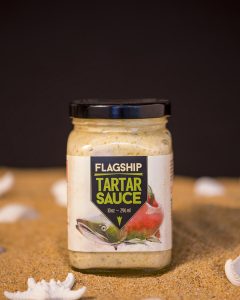 The two condiment sauces in the line are Flagship Tartar Sauce and Shoreline Cocktail Sauce. Flagship Tartar Sauce has a mayonnaise base with capers, sweet peppers, lemon juice and “just the right amount of dill, so it’s a good complement to a fried fish dish,” Rhodes said. It’s packaged in a 10-ounce jar that retails for $5.99. Shoreline Cocktail Sauce includes garlic and onions along with horseradish and some lemon juice to brighten the flavors. “Just grab a shot glass and throw in your shrimp or crab,” Rhodes said. The 10-ounce jar of this also retails for $5.99.
The two condiment sauces in the line are Flagship Tartar Sauce and Shoreline Cocktail Sauce. Flagship Tartar Sauce has a mayonnaise base with capers, sweet peppers, lemon juice and “just the right amount of dill, so it’s a good complement to a fried fish dish,” Rhodes said. It’s packaged in a 10-ounce jar that retails for $5.99. Shoreline Cocktail Sauce includes garlic and onions along with horseradish and some lemon juice to brighten the flavors. “Just grab a shot glass and throw in your shrimp or crab,” Rhodes said. The 10-ounce jar of this also retails for $5.99.
There are two seasonings: Lemon Herb Seasoning was designed especially for white fish like halibut, cod or rockfish, but it’s also good on chicken, while the Seattle Artisan Foods Salmon Rub combines some brown sugar and a little bit of heat for a sweet and spicy flavor that offers a true taste of Seattle.
All of the products are shelf-stable, and although distribution is currently limited to the Pacific Northwest, national distribution is on the horizon. For further information, call Seattle Artisan Foods at 877.337.0672 or visit www.seattleartisanfoods.com.

